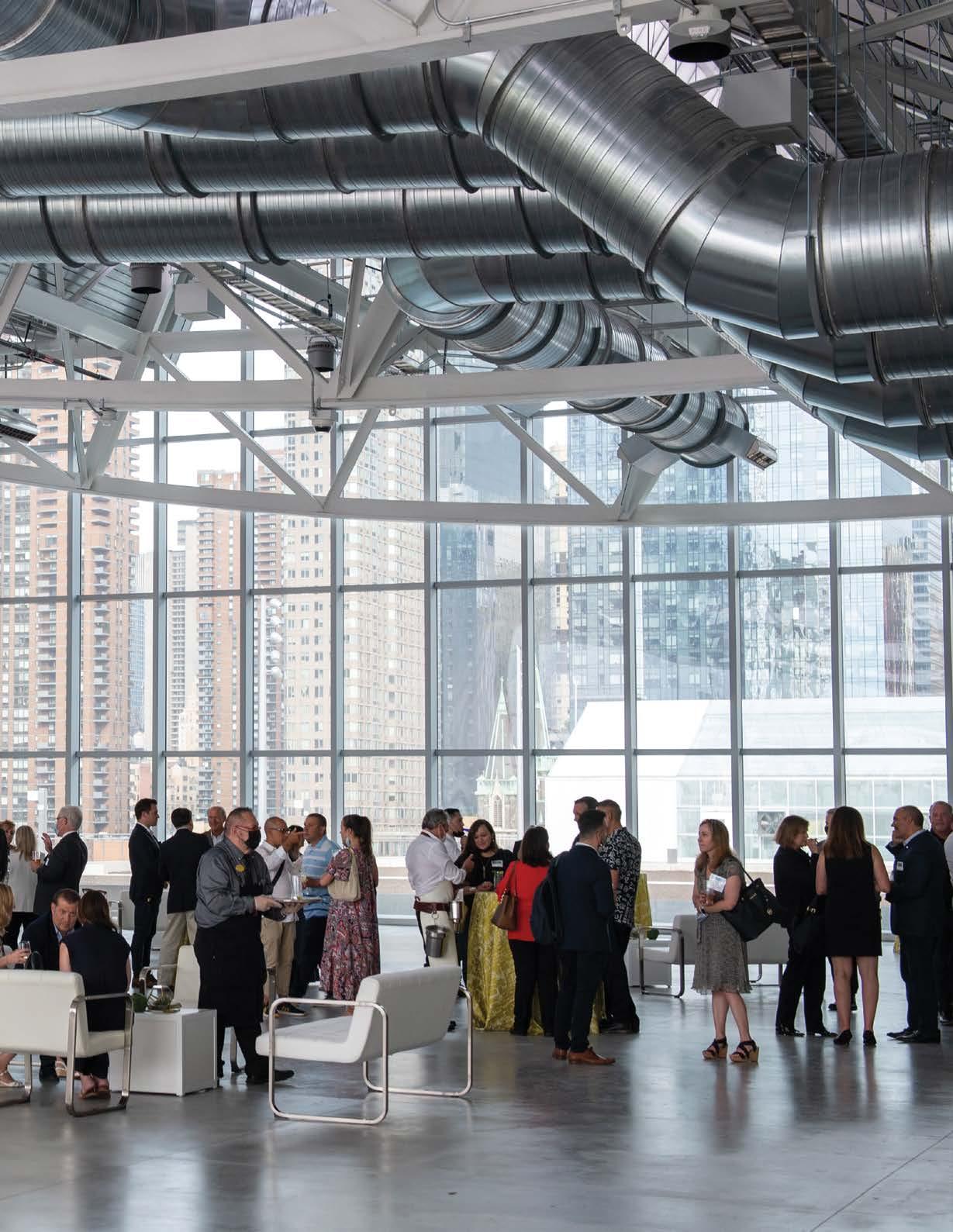
4 minute read
COMPLETING HISTORY

In September 2021, the 200,000 square-foot expansion rooftop was completed, and it has quickly become a favorite of event and meeting planners and environmental enthusiasts. The rooftop features a 15,000 square-foot, glass-enclosed pavilion with a retractable garage door that connects guests to the outdoor terrace, which includes a meadow and shade garden with native and pollinator-friendly plants, as well as an orchard with 32 apple trees and six pear trees. On the eastern side of the rooftop, there's a one-acre rooftop farm that provides fresh produce for on-site consumption – with recycled rainwater used for irrigation. There's also a greenhouse that will allow farmers to grow produce and support our in-house chefs throughout the year. Brooklyn Grange, a Brooklyn-based urban farming company, is managing the day-to-day operations of the farm and the greenhouse and works closely with Cultivated to direct crops to our on-site kitchens where the produce is incorporated into client meals.
OTHER HIGHLIGHTS INCLUDE:
• Roof-to-Table. With agricultural soil 18 inches deep, the rooftop farm is expected to grow about 40,000 pounds of produce per year, creating a true roof-totable experience. Members of Brooklyn Grange plan to grow more than 50 crops in the coming year – from arugula to zucchini – and are working closely with our in-house chefs to determine seasonal crop plans tailored to the clients’ needs; • The Greenhouse. The rooftop greenhouse is equipped with the latest AgTech innovations that will be managed by members of Brooklyn Grange so produce can be grown throughout the year – despite weather conditions;

• Water Conservation. The installation of two 334,000-gallon underground retention cisterns helps capture and treat rainwater to be used for irrigation on the roof, reducing the need for potable water for irrigation by at least 50; • Solar Farm. More than 3,000 solar panels will be installed on the existing and expansion rooftops, making it the largest rooftop solar farm in
Manhattan. In conjunction with the New York Power
Authority and Siemens, the project is expected to generate 1.7 megawatts of solar energy with an additional 3.5 megawatts of battery storage, providing the convention center with more than 2 gigawatt hours per year; and • Diverted waste. 75% or more of all construction waste was diverted from landfills for reuse, and all construction materials were chosen with sustainable characteristics including high recycled content, locally sourced and sustainably harvested wood. The expansion’s sustainable elements serve as the latest chapter in the Javits Center’s sustainability story, which includes a 6.75-acre green roof that is home to 35 bird species, five bat species and five bee hives. With cutting-edge equipment and a focus on efficiency, energy consumption has been reduced by 26 percent, translating into millions of dollars in savings.
Protecting New Yorkers
The Javits Center’s vaccination center reinforced the importance of the convention center to the New York community, proving the value of such a facility in a time of unimaginable crisis.

From January to July 2021, more than 646,000 vaccines were distributed inside our halls – helping to put the city and state on the road to recovery. Inside the vaccination center, four stations were created – an information center, a registration area, a vaccination area and a waiting area (to ensure there were no adverse effects) – and our staffers worked side-by-side with National Guard members and officials from the state Department of Health to ensure each station operated in a seamless fashion. At the peak of activity, 14,000 vaccines were administered in one day. To improve the experience, we partnered with a nonprofit organization, Sing for Hope, and local violinist Victoria Paterson, who started her own nonprofit, Music and Medicine, to bring musicians to play for New Yorkers on a daily basis, and the results were astounding. For a few hours each day – for more than 120 consecutive days – a string quartet played a variety of classical and pop songs – providing employment to out-of-work musicians and lifting the spirits of those in the building for their vaccine. In the end, the sounds of music seem to soothe people still affected by the isolation caused by the pandemic. “This past year has been a highly stressful environment, and people’s mental health has been suffering,” Dr. Azmatullah Hussaini told the Associated Press. “But with people coming for the vaccine, this environment is filled with hope because this is a way to end the pandemic.” We also installed a Wall of Thanks where New Yorkers could post messages of gratitude and appreciation for the workers on site helping to administer the vaccine. In total, we collected about 50,000 notecards from visitors who expressed words of hope and relief after receiving the vaccine. In September, Governor Kathy Hochul (then Lieutenant Governor) visited the vaccination center in support of our efforts, commending the staffers for their dedication to New York’s recovery. As part of our JavitsCares program, hundreds of items used in the operation of the field hospital and the










